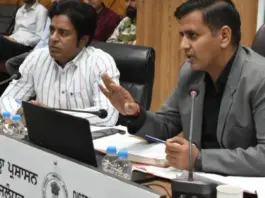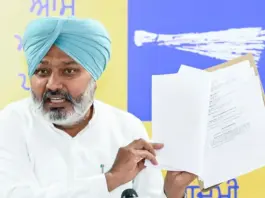A quiet revolution is happening in Punjab’s schools. It’s not written in books, nor taught only by traditional teachers. This is a revolution where a girl in Malerkotla is learning to protect herself from online dangers, a boy in Pathankot is understanding why his grandmother’s banking information must be kept secret, and an entire generation is being equipped not with fear but with awareness. Under Chief Minister Bhagwant Mann’s forward-thinking leadership, Punjab Police’s ‘Saanjh’ initiative has moved beyond traditional policing to build a bridge of trust, partnership, and active community engagement that is now shaping Punjab’s children’s future.
The ‘Cyber Jaago’ initiative, started by Punjab Police’s Cyber Crime Division, shows a major shift from reactive policing to preventive education, reaching every corner of Punjab where young minds are navigating the complex digital world. The first training workshop trained 75 teachers with plans to cover 3,968 government high schools across Punjab. This isn’t just another government program – it’s a protective shield being woven by the Mann government around Punjab’s most precious resource: its children. The emotional importance of this initiative becomes clear when we know that 76% of children aged 14-16 now use smartphones for social media, making them vulnerable to cyberbullying, identity theft, and online exploitation.
What makes Punjab Police’s approach under the AAP government unique is the deep collaborative spirit embedded in the word ‘Saanjh’ – meaning partnership. The Saanjh project has established district community police resource centers, 114 sub-division community policing facility centers, and 363 police station outreach centers across the state, creating an unprecedented network where police officers don’t just enforce law but become guides and protectors of future generations. Every week, Punjab Police personnel visit schools not in intimidating uniforms of authority, but as older siblings and teachers who speak the language of care and concern.
Special DGP V. Neerja, head of the Cyber Crime Division, emphasized that “with the widespread availability of digital content, children are facing both online opportunities and dangers,” highlighting how the COVID pandemic accelerated children’s digital immersion, often beyond their parents’ understanding. The Mann government quickly recognized this vulnerability and responded with a comprehensive strategy. Teachers trained under Cyber Jaago don’t just teach cyber hygiene – they empower students to identify potential threats, understand AI-related dangers, and effectively respond to online child sexual exploitation.
The beauty of the Saanjh initiative lies in its emotional connection with Punjab’s cultural spirit of ‘saanjhe chulhe’ – the shared stove that symbolizes collective responsibility. Through Shakti Helpdesk programs, Punjab Police organizes awareness seminars in schools in districts like Sri Muktsar Sahib and SBS Nagar, educating students about good touch and bad touch, child exploitation, drug abuse dangers, and helpline number 112/1098. The Mann government has ensured that every child in Punjab knows they have a protector in their police force.
What transforms this initiative from policing into a social movement is the integration of technology with human sensitivity. The PP Saanjh mobile application allows citizens to digitally access police services, get FIR copies, and complete verification processes from anywhere in Punjab, while police personnel simultaneously conduct face-to-face sessions in schools. Under CM Bhagwant Mann’s governance philosophy, police are not distant enforcers but accessible partners in community welfare.
When a 14-year-old student learns about online financial fraud, that knowledge goes home to protect grandparents from UPI scams. When a girl understands her digital rights, she becomes an advocate for her friends’ safety. As DGP Neerja said, this is not a one-time campaign but the beginning of a long-term effort to make cyber security part of Punjab’s school culture. Mann government’s vision is clear: creating a generation that is digitally literate, socially aware, and empowered to protect themselves and others.
The success of Saanjh under the AAP government reflects a fundamental shift in governance philosophy – from top-down directives to bottom-up partnership. Each Saanjh center operates as an autonomous registered society with police-public committees, ensuring community voices shape policing priorities. This democratic approach, supported by CM Mann, has transformed public perception of police from enforcers to enablers, from authority figures to advocates.
Punjab’s Saanjh initiative today stands as a beacon for the entire country – a model where 21st-century policing meets timeless Punjabi values of community and care. Under Chief Minister Bhagwant Mann’s leadership, the AAP government has proven that true security comes not from more police stations but from more aware citizens; not from harsh punishments but from preventive education; not from creating fear but from building confidence. This is the lasting legacy of the Mann government: a Punjab where every child steps into the future with confidence, protected by knowledge, strengthened by awareness, and supported by a police force that truly acts as ‘Saanjh’ – a partnership.




